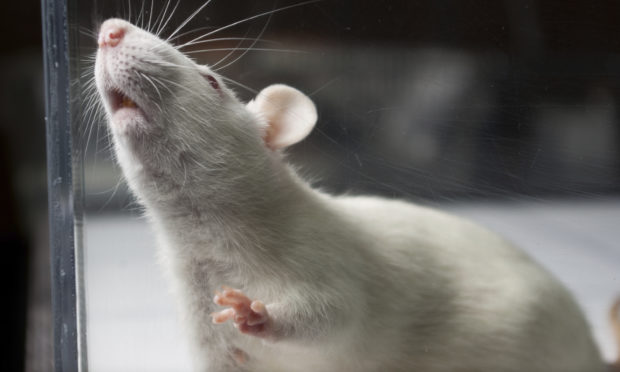Almost 200 animals are believed to have suffered such severe distress during testing at Dundee University last year the incidents had to be reported to the Home Office.
The incidents were among 35,000 animal deaths during research by the university in the 2018 calendar year, new figures reveal.
The experiments are assessed using a ‘pain rating’ — essentially from one to five — with incidents reported to the UK Government department when the extent of the suffering caused is thought to be high.
European law states that killing during animal research must be done with “minimum pain, suffering and distress”.
Some 178 experiments by the university were in this most serious category.
The Medical Research Council (MRC) states these are experiments that can cause severe pain, suffering or distress or long-term moderate pain, suffering or distress.
The university says it adopts alternatives “whenever possible” but stressed using animals is sometimes necessary in producing “greatly important” research into serious health problems.
The vast majority of experiments were on mice – around 34,000, while rats were used in 1,200 and frogs in 312.
In the past, Dundee University has also killed rabbits as well as hamsters but has reduced the numbers of animals used in tests in recent years.
John Patrick, from the grassroots charity Scotland for Animals, said it was “downright frightening” that Dundee University is still relying on “discredited, shot-in-the-dark research methods”.
He said: “The number classified as ‘severe’ is alarming, but taking into account the misery these animals endure throughout so-called mild and moderate procedures, not to mention their captivity and killing, is completely unacceptable too.
“This is having a detrimental impact on the safety and welfare of both humans and non-humans. Animals are bred, tortured and killed for the personnel involved to lead medicine down blind alleys.
“We need government and institutions to scrap this nonsense and back real, scientific research without the abuse of animal “models”.”
The university is not known to have been the subject of any investigations by the Animals in Science Regulation Unit, he body responsible for investigating any failure to comply with the required standards, and there have been no suggestions of any wrongdoing.
The vast majority of the tests — just over 70% — were classified in the lowest pain bracket named ‘sub-threshold’.
These are tests which were originally assigned an above-threshold pain or suffering classification but when the work was undertaken the actual level of suffering was below that which would exceed the threshold at which procedures are licensed.
The number in the highest, 178, amounts to under 1% of the total.
It comes as the Home Office publishes its annual figures for the numbers of tests being carried out UK-wide in 2018.
It showed a 16% increase in experiments on dogs and revealed 18% (643,142) of the 3.52 million experiments were assessed as having caused moderate or severe suffering.
A spokesperson for Dundee University said: “We are required by law to use alternatives to animals in research where they are available. The results of our research are of great importance in better understanding and developing treatments and better prevention for serious health problems including Alzheimer’s, Parkinson’s disease, cancer, heart disease, diabetes, genetic disorders and infectious diseases.
“Alternatives to the use of living animals, such as computer models and increasingly sophisticated cell culture systems, are adopted whenever possible, but procedures that involve animals continue to be necessary in many cases.
“The university takes its ethical and legal responsibilities very seriously. All our work is carried out so the least possible harm is done in collecting information, and the replacement of animals with other research methods wherever possible.”
The university’s policy on animals in research is available on its website.









